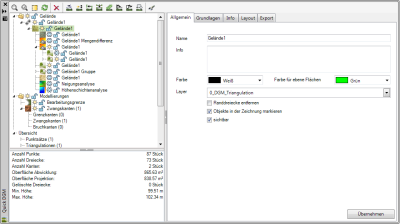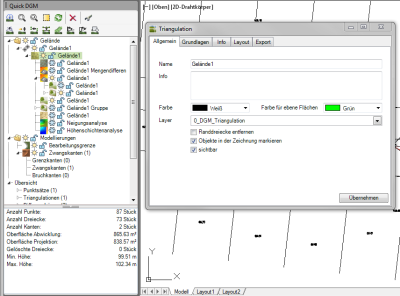Table of Contents
Quick-DTM (AutoCAD based)
Command: QDGM
Description
The window Quick DGM  is the central switching point for all terrain model objects and contains all basic functions of digital terrain processing in the products GREENXPERT, LANDXPERT, CADXPERT and ETB-CAD. The DTM objects contained in the drawing are listed in the tree structure with their dependencies. Below is a brief overview of the selected DTM object. If necessary, further information on the selected DTM object is displayed in the right-hand area (see chapter Working methods).
is the central switching point for all terrain model objects and contains all basic functions of digital terrain processing in the products GREENXPERT, LANDXPERT, CADXPERT and ETB-CAD. The DTM objects contained in the drawing are listed in the tree structure with their dependencies. Below is a brief overview of the selected DTM object. If necessary, further information on the selected DTM object is displayed in the right-hand area (see chapter Working methods).
Information on the individual functions in the DTM can be found in the following topics:
- Points:
- Surfaces:
- Calculation:
- Data exchange:
DTM objects
All of DATAflor CAD generated DTM data (objects) are saved in the drawing and not in separate configuration files. This simplifies data backup and the creation of safety copies, since the drawing only has to be copied.
The following figure shows the object hierarchy of the DATAflor CAD terrain model objects represented graphically:
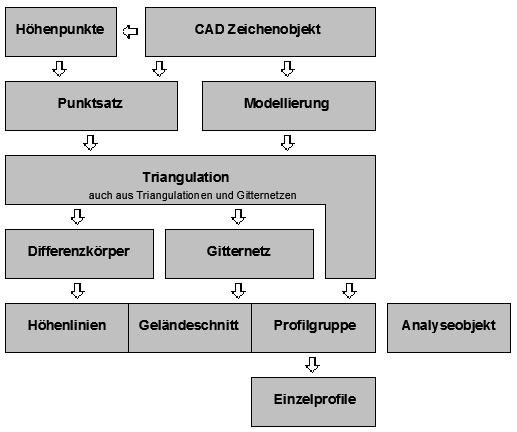
Both elevation points and drawing objects can be used as the basis for a terrain model.
The arrows show the relationship between the objects, ie which objects can be derived from which.
A special DTM object is the triangulation, as it can be created not only from point sets and modeling, but also from subsequent objects (triangulations and grids).
All objects are dependent on one another. This means that if, for example, the position of a point is changed, all DTM objects derived from it are automatically updated and recalculated.
Working methods
When creating DTM objects DATAflor CAD three ways of working.
Advantages of working with the Quick-DTM window
- Use of control buttons for various functions (e.g. to create triangulations:
Ctrl + Alt + T). - Dragging drawing objects onto the nodes in the DTM overview in order to create objects such as triangulations and modeling directly.
For the Dragging drawing objects from the drawing into the Quick-DTM window and for moving / copying objects within the Quick-DTM window, the license for the extended terrain model functions is required.
Features
Functions in the tree structure
All available functions for the corresponding DTM object are displayed with the right mouse button. The functions provided are programmed in a context-dependent manner and are therefore only activated when this happens. In the groups terrain and Modeling can be used to structure the terrain model objects New groups invest.
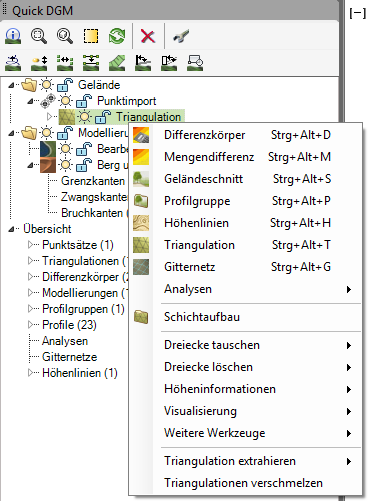
Object icon: Double click on the symbol of the DTM object opens / shows the Information to the selected DTM object in the area / window.
visibility: Double click sets the object visible / invisible. The display of the visibility in the drawing is independent of a control via layers. If objects are switched invisible (eg a point record that is no longer required), this increases the computer speed.
Further options are offered with the right mouse button. With these functions, individual tree sections can easily be switched ON and OFF without having to do this separately for all individual objects.
| Isolate object | Switches the visibility ON for the selected object and OFF for all other objects. |
| Isolate branch | Switches the visibility for the selected object and all subordinate objects ON. The visibility of other objects is set to OFF. |
| Branch invisible | Switches the visibility for the selected object and all subordinate objects OFF. The visibility of other objects is not changed. |
| Branch visible | Switches the visibility for the selected object and all subordinate objects ON. The visibility of other objects is not changed. |
fixation: Double click locks / unlocks the object. Further options are offered with the right mouse button. With the fixation the calculation of objects (the object dependency) can be interrupted. Changes to basic objects therefore no longer affect the fixed objects. This can significantly increase the processing speed. After a fixation has been removed, the object and all dependent DTM objects must also be Recalculate updated.
Example: For a triangulation, extensive contour lines are calculated, which are then fixed. If the triangulation is changed, the contour lines are not recalculated. This can be carried out in a controlled manner at the end of processing.
Go to the Opening and closing the knot you can also use the following keys:
| + | opens the selected node |
| Ctrl & + | opens the selected and all subordinate nodes |
| - | closes the selected node |
Functions in the toolbox
| Info: If necessary, opens the area or the window with the information on the selected DTM object. Properties can be edited here. The information is also displayed if you double-click the symbol of the DTM object in the tree structure. |
|
| zoom: This function is used to zoom in on the DTM object selected in the Quick DTM window in the drawing area. | |
| Find objects: This function is used to find the drawing objects in the Quick-DTM window. After selecting the object in the drawing, the DTM object is marked in the tree structure. | |
| Mark on: If an object is marked in the Quick-DTM window, the corresponding drawing object is also marked on the screen. | |
| Recalculate: Recalculates the marked DTM object and all objects dependent on it. This is necessary, for example, after lifting a fixation. | |
| Configuration: Opens the DTM configuration window in which properties for the DTM objects can be predefined (see chapter Configuration). |
Further functions from the toolbox can be found in the following topics:
Configuration
With the help of the configuration, properties (e.g. color, layer and layout settings) can be predefined for the DTM objects.
The settings within the configuration correspond to those in the info window. Further information about the options within the configuration can be found in the help for the respective DTM objects.
The following objects differ from the display of the DTM objects in the info window:
modeling
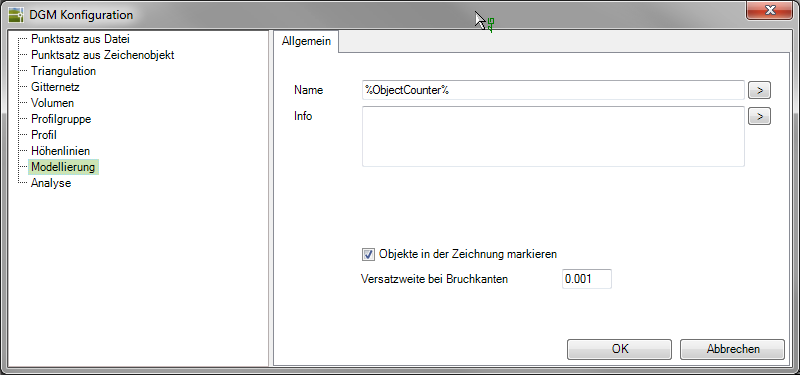
The option Offset width at break lines specifies the distance between the constrained and boundary edge.
Analysis
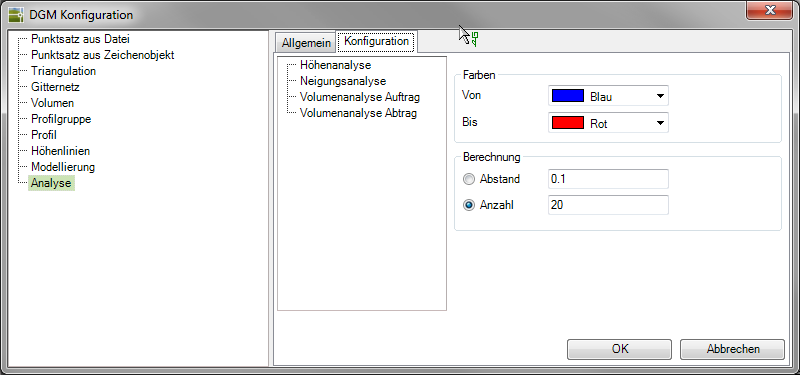
The color range can be specified with two colors for each analysis. For the calculation two options are available.
With the option distance an interval is set based on which the color gradation is carried out. If the distance = 1, a new color value is used every 1 meter / degree. The respective intermediate color is interpolated from the color table.
With the option Quantity the value range of the calculation basis (e.g. lowest and highest point of a triangulation) is divided by the specified number.
The configuration files are stored in the user directory of DATAflor CAD saved.

